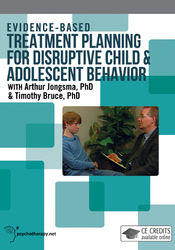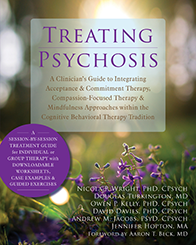Oct 15, 2015 | Video Reviews
 Psychotherapy.net continues to expand its library with additional videos and materials. In reviewing their streaming video on Evidence-Based Treatment Planning for Disruptive Child and Adolescent Behavior, I found the video to be comprehensive and informative. Drs. Timothy Bruce and Arthur Jongsma first focus on explaining the various definitions of behavioral disorders and their related literature. The focus of the video is on the disruptive behavior of the oppositional and conduct type. The viewer is also reminded that many disruptive behaviors can be included in a variety of disorders such as ADHD and ODD. Dr. Bruce then discusses a brief history of the movement to solidify empirically supported treatments (ESTs). One strong goal of the video, which is done well, is to “demonstrat[e] how a treatment plan can be empirically informed by incorporating goals, objectives, and treatment interventions that are consistent with evidence-based practices.” The first half of the hour-long video is dedicated to the education of counselors, and includes citing additional resources and literature that have had an impact on our understanding of counseling regarding disruptive behaviors. The authors also discuss the appropriate use of role modeling, school–counselor–parent interactions, and conflict management techniques. This comprehensive review of resources is given in combination with slide graphics, which highlight the main points to help the viewer gain a strong understanding of the material.
Psychotherapy.net continues to expand its library with additional videos and materials. In reviewing their streaming video on Evidence-Based Treatment Planning for Disruptive Child and Adolescent Behavior, I found the video to be comprehensive and informative. Drs. Timothy Bruce and Arthur Jongsma first focus on explaining the various definitions of behavioral disorders and their related literature. The focus of the video is on the disruptive behavior of the oppositional and conduct type. The viewer is also reminded that many disruptive behaviors can be included in a variety of disorders such as ADHD and ODD. Dr. Bruce then discusses a brief history of the movement to solidify empirically supported treatments (ESTs). One strong goal of the video, which is done well, is to “demonstrat[e] how a treatment plan can be empirically informed by incorporating goals, objectives, and treatment interventions that are consistent with evidence-based practices.” The first half of the hour-long video is dedicated to the education of counselors, and includes citing additional resources and literature that have had an impact on our understanding of counseling regarding disruptive behaviors. The authors also discuss the appropriate use of role modeling, school–counselor–parent interactions, and conflict management techniques. This comprehensive review of resources is given in combination with slide graphics, which highlight the main points to help the viewer gain a strong understanding of the material.
There are a number of clips that model how a counselor would work with parents, as well as with a teenage male, and which highlight how situations can be de-escalated while dealing with the negative behaviors in a positive manner. Techniques are first processed between the counselors and then role modeled through counseling sessions, either with the parents or the child. Following the role modeling sessions the counselors revisit the learning objectives for the section and discuss how they were illustrated through the role modeling. While some of the role-plays seem a little bit scripted, the material is presented in a realistic fashion so that the viewer can see a strong example of how theory, techniques, and practice combine to help clients make positive changes.
The program is well produced with a smooth flow between instruction and demonstration. It is in a video format that is visually clear with good sound, which is appropriate for viewing by an individual or for use with an entire class. One strength of the program is that the video is presented with a complete script, with the added capability of clicking on a word in the script and starting the video at the correlating spot. This capability allows for easy review and navigation throughout the video.
Overall, I would recommend this video as an introduction for beginning counselors-in-training or for professionals who want to review their understanding in this area. Online education has learned that hour-long videos are not the best for comprehension, yet with the Psychotherapy.net system a person can easily return to view the material in smaller sections. The use of these videos as a learning tool is strongly recommended and technology has now allowed us to access these materials easily and at a time of our choosing.
John Wiley & Sons, Inc. (Producer). (2011). Evidence-Based
Treatment Planning for Disruptive Child and Adolescent Behavior. (Available in video streaming fromhttps://www.psychotherapy.net/video/evidence-based-treatment-planning-child-behavior-problems)
Available in streaming format as part of video subscription at www.psychotherapy.net/subscriptions.
Reviewed by: Dr. Matthew Mims, NCC, University of Nebraska at Kearney.
The Professional Counselor
https://tpcjournal.nbcc.org/
Oct 1, 2015 | Book Reviews
 In Treating Psychosis: A Clinician’s Guide to Integrating Acceptance and Commitment Therapy, Compassion-Focused Therapy and Mindfulness Approaches within the Cognitive Behavioral Therapy Tradition, Nicola P. Wright et al. offer valuable knowledge and concrete, practical application of theory, interventions and strategies for clinicians looking to augment their work with individuals who experience psychosis. The authors do an excellent job of laying a foundation that explains how psychosis can cause problems for individuals suffering from it, while concurrently maintaining a compassionate stance.
In Treating Psychosis: A Clinician’s Guide to Integrating Acceptance and Commitment Therapy, Compassion-Focused Therapy and Mindfulness Approaches within the Cognitive Behavioral Therapy Tradition, Nicola P. Wright et al. offer valuable knowledge and concrete, practical application of theory, interventions and strategies for clinicians looking to augment their work with individuals who experience psychosis. The authors do an excellent job of laying a foundation that explains how psychosis can cause problems for individuals suffering from it, while concurrently maintaining a compassionate stance.
The book is divided into nine modules that build upon one another sequentially and address different components of the counseling process, including initial conceptualization and group implementation, the therapeutic relationship, assessment, treatment planning, emotion regulation and resilience, treating distressing thoughts and voices, and recovery maintenance. Throughout the modules, Wright et al. include clinical examples and exercises to help the reader apply the text to clinical practice. The book also has an abundant appendix of forms that counselors can utilize in every stage of work with clients, from initial screening and assessment to more in-depth work after initial rapport occurs, such as emotion identification, core beliefs, coping strategies and voice management, in order to help clients minimize distress. Additionally, the authors provide a thorough collection of resources and further reading for clinicians to supplement their expertise and practice.
The authors are concise and craft a comprehensive strategy for working clinically with this population in only 159 pages. The text is approachable and conversational and the subject matter is explained with person-centered compassion and sensitivity. The interventions recommended are easy to apply and simple in their explanation. The overarching philosophy promoted by the authors is an intent focus on understanding clients’ experiences with voices and distressing thoughts. With this better understanding, clinicians can empower clients to establish more control in their lives using a blend of cognitive-behavioral, compassion-focused, mindfulness, and acceptance and commitment techniques—including commanding voices, bringing beliefs more in line with personal values, and ultimately establishing a more positive relationship with thoughts and voices—in order to enhance emotional regulation, build resilience, and increase overall congruence to decrease distress for clients experiencing psychosis.
The main limitation associated with the book is the breadth of approaches that the authors attempt to include in their comprehensive approach. While the blending of the four separate approaches of acceptance and commitment therapy, compassion-focused therapy, mindfulness, and cognitive-behavioral therapy is ambitious and often successful, at times the overarching strategy comes across as piecemeal and may benefit from a more fully integrated perspective. For example, while the authors utilize a variety of interventions from each of the approaches under the cognitive-behavioral umbrella, at times the integration of these four strategies does not feel fully realized. However, in terms of applying the information in everyday practice, the book is practical and easily applicable.
Treating Psychosis is a useful resource for counselors who work regularly with a clientele experiencing psychosis that interferes with everyday life. The book offers straightforward strategies, interventions and perspectives for decreasing distress around invasive voices and thoughts.
Wright, N. P., Turkington, D., Kelly, O. P., Davies, D., Jacobs, A. M., & Hopton, J. (2014). Treating psychosis: A clinician’s guide to integrating acceptance & commitment therapy, compassion-focused therapy & mindfulness approaches within the cognitive behavioral therapy tradition. Oakland, CA: New Harbinger.
Reviewed by: Allison Jeanne Agresti, NCC, McLeod Addictive Disease Center, Marion, NC.
The Professional Counselor
https://tpcjournal.nbcc.org/
 Psychotherapy.net continues to expand its library with additional videos and materials. In reviewing their streaming video on Evidence-Based Treatment Planning for Disruptive Child and Adolescent Behavior, I found the video to be comprehensive and informative. Drs. Timothy Bruce and Arthur Jongsma first focus on explaining the various definitions of behavioral disorders and their related literature. The focus of the video is on the disruptive behavior of the oppositional and conduct type. The viewer is also reminded that many disruptive behaviors can be included in a variety of disorders such as ADHD and ODD. Dr. Bruce then discusses a brief history of the movement to solidify empirically supported treatments (ESTs). One strong goal of the video, which is done well, is to “demonstrat[e] how a treatment plan can be empirically informed by incorporating goals, objectives, and treatment interventions that are consistent with evidence-based practices.” The first half of the hour-long video is dedicated to the education of counselors, and includes citing additional resources and literature that have had an impact on our understanding of counseling regarding disruptive behaviors. The authors also discuss the appropriate use of role modeling, school–counselor–parent interactions, and conflict management techniques. This comprehensive review of resources is given in combination with slide graphics, which highlight the main points to help the viewer gain a strong understanding of the material.
Psychotherapy.net continues to expand its library with additional videos and materials. In reviewing their streaming video on Evidence-Based Treatment Planning for Disruptive Child and Adolescent Behavior, I found the video to be comprehensive and informative. Drs. Timothy Bruce and Arthur Jongsma first focus on explaining the various definitions of behavioral disorders and their related literature. The focus of the video is on the disruptive behavior of the oppositional and conduct type. The viewer is also reminded that many disruptive behaviors can be included in a variety of disorders such as ADHD and ODD. Dr. Bruce then discusses a brief history of the movement to solidify empirically supported treatments (ESTs). One strong goal of the video, which is done well, is to “demonstrat[e] how a treatment plan can be empirically informed by incorporating goals, objectives, and treatment interventions that are consistent with evidence-based practices.” The first half of the hour-long video is dedicated to the education of counselors, and includes citing additional resources and literature that have had an impact on our understanding of counseling regarding disruptive behaviors. The authors also discuss the appropriate use of role modeling, school–counselor–parent interactions, and conflict management techniques. This comprehensive review of resources is given in combination with slide graphics, which highlight the main points to help the viewer gain a strong understanding of the material.
